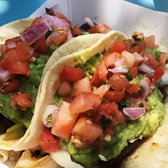Kasper Kasabach- Week 1
Smillow center for translational research, my lab
Manas and I both arrived on Saturday to get settled into our apartment and learn about the area before beginning our time in the lab. After a fairly stress free move in, we decided to explore the area around our apartment. We walked around for a while and finally ended up eating at the world famous taco shop right across the street, Honest Tom's Taco Shop. The burrito that I ordered was massive, no one was able to finish theirs either. On Sunday, we had to figure out the essentials: go grocery shopping, find the nearest laundromat, and of course find the nearest pizza place. The next thing for us to do was figure out how to get our Penn cards and see if we could get gym memberships. We couldn't do either that day, and weren't allowed to get memberships at the Penn gym at all because we were too young, but we were able to get our Penn cards the next day.
The focus of this first week was training, learning, and beginning experiments. After
attending a general safety session on Monday morning, I met with my PI, Saar
Gill and Kristen Blouch, the person that I would mainly be working with. She showed me around the lab,
teaching me the locations of all of the supplies that I would use in the
future. In addition, she introduced me
to the entire staff of the lab. We began
our first project on Monday by dissecting mice, removing the legs and
spines. The mice used are a special kind
of mice called NSGS mice, meaning that they don’t have immune systems. The bones from the spine and legs were then
stripped of all excess cartilage, tissue, and fat that may have remained,
followed by a wash with ice cold PBS.
Next, a mortar and pestle were used to crush the bones in order to
extract the monocytes, which would later differentiate into macrophages. From these five mice, 130,000,000 monocytes
were captured. , about 13,000 per microliter. Next, 769ul of the cell solution was added
to five flasks in order to have 10,000,000 in each flask. 80,000,000 other cells were resuspended in
8ml of freezing media. Each vile was
frozen with 10,000,000 cells in it.
There were a total of 8 vials.
Later, we had to split the line of
macrophages. At this point the media was
yellow, signaling that it had been used up and that the cells and been growing
and dividing. Trypsin was then added to
the flask to free the macrophages from the walls. The macrophage line that we were working with
was particularly sticky and needed a further dosage of trypsin to loosed their
hold on the flask walls. These cells
were then scraped of into the media. Next, 30ml of new media was added to
replenish the cells. This new solution
was divided into 5 separate flasks and 30 more ml of media were added to allow
the cells to continue growing and living.
The next experiment that we ran was a
Scov3 Retro orbital injection. The first thing that needed to be done was
centrifuging the solution of cells and buffer on program 2 (5 minutes at
500g). After this spin was completed,
the vacuum in the safety cabinet was used to dispose of all of the liquid on
top of the cells. Later, 4ml of trypsin were added to help dislodge the cells
from the side of the flask, as was done in the previous experiment. The flask was tilted back and forth, allowing
the trypsin to pick the cells up with it.
Then, 8ml of R10, a media solution, were added to the flask and the
mixture was spun down again on the same program. The soup was then discarded. 5 more ml of R10 were added to allow for a
proper count of the total number using the Moxiflow machine. The way this machine works is by inserting a
disk that has a channel on it. You then
pipet 75ul of your cell solution into this channel on the disk and close the
machine, selecting viability count on the touchscreen. In this solution, the cells were much more
dense with 600,000 cells per micro liter. The solution was centrifuged another time at 500g for 5 min. The soup was again discarded and 50ml of sterile PBS was added. This new solution was then put through a 70ul strainer to weed out any of the large or dead cells, as well as any other particles that may have made it through the process. The mixture was then added to special cryotubes and mixed with freezing buffer. Immediately the solution needed to be frozen for later use. The solution was spun down on program 2 once again. The soup was dumped off and versene was added
and the cells were resuspended in it.
The solution needed to sit for 5 min to allow the versene to take
effect. Add 10ml of medece. Pipet up and down again to resuspend. Finally, the solution was centrifuged and the pellet was collected and studied.
On Friday, there was a meeting that the entire oncology department attended. This meeting was kept confidential and took over three hours. The meeting was about new ideas and techniques that are being developed in Smillow for cancer treatment.








Comments
Post a Comment